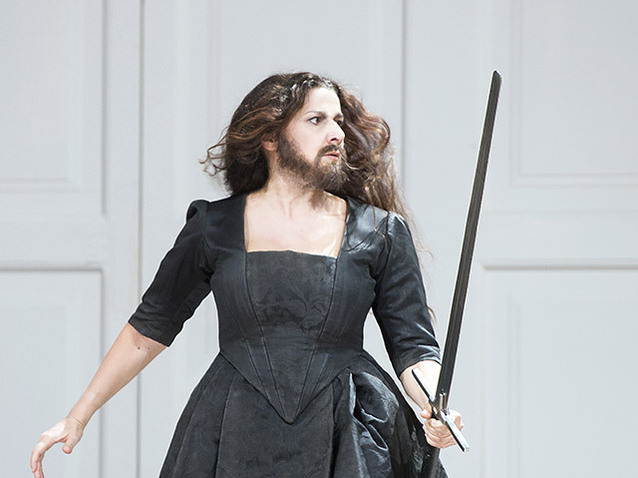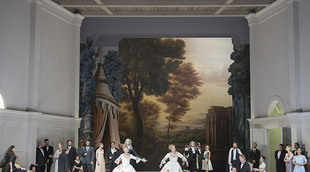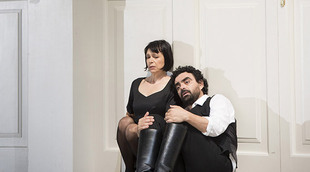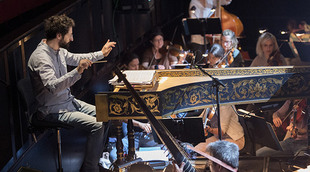 © (c) Monika Rittershaus
© (c) Monika Rittershaus
To inspire his production of Handel’s Ariodante for the Salzburg Festival, director Christof Loy turned to a novel that shares a name with the opera’s source material (Ariosto’s Orlando furioso): Virginia Woolf’s Orlando. He makes no secret of this source, as quotes from Orlando (in Italian, for the sake of linguistic continuity) interrupt the overture and precede the third act. The concept is both consistent and effective. A mishmash of costume time periods from the medieval era through the 21st century reflects Woolf’s protagonist’s long life. Ariodante transforms into a woman (as Orlando does in Orlando), which serves as a nod to the “trouser role” nature of the part and also explains why Ariodante’s friends are slow to recognize him/her when s/he reappears after his/her supposed death.
A refresher for those confused by Handel’s convoluted plots: Ariodante and the princess Ginevra are in love and to be married. Polinesso wants the throne and plots to impede their marriage. He enlists the help of Ginevra’s lovesick lady-in-waiting Dalinda, who dresses as Ginevra and invites Polinesso into her rooms at night. Ariodante sees this (as Polinesso planned), recognizes that Ginevra is unfaithful to him, and throws himself into the ocean. Ariodante’s brother Lurcanio seeks revenge for his death, publicly accusing Ginevra of adultery. The king (Ginevra’s father) grants him a trial by combat; if he wins, Ginevra must die. Polinesso volunteers to defend Ginevra, but Lurcanio slays him. Ariodante arrives just in time—his suicide attempt failed. Dalinda and the dying Lurcanio confess all, revealing that Ginevra is virtuous. The lovers are re-united, and the court celebrates.

Ariodante © Monika Rittershaus

Sandrine Piau, Rolando Villazon © Monika Rittershaus
The focus in this production is on gender. Ariodante and Ginevra undergo a swap. Polinesso mockingly drops Ginevra’s dress at Ariodante’s feet to prove her infidelity. The heartbroken Ariodante first caresses the garment, and then dons it. In the woods, s/he is gender-ambiguous, with a Conchita Wurst-style dress-plus-beard combination, but by the time she returns to court she has embraced her femininity and lost the facial hair. Meanwhile, the doomed Ginevra has no souvenirs of Ariodante except his jacket and boots, which she puts on to die. When they find each other again, they are each wearing the other’s clothes.
One of Loy’s signature skills is heightening the comedy of operas. This is particularly welcome in Ariodante, when characters have a tendency to launch in highly repetitive six-minute flights of coloratura. A drunken Ariodante stumbles around the stage for “Con l’ali di costanza,” hiccupping out high ornaments and leering suggestively at Polinesso and Dalinda. Another comedic success comes in “Dopo note,” when the young men of the court are fawning on the newly female Ariodante. They try to bring her a chair, light her a cigar, and even serve as a human ashtray—and she intentionally makes those tasks difficult for them.
Loy also manages the opera’s difficult ending well. The love duet “Bramo aver mille vite” is sweet without pretending that everything is okay—both Ariodante and Ginevra reveal lingering feelings of guilt and sadness. The celebratory ballet is broken: Ginevra watches in horror as the dancers crumple to the ground and the shade of Polinesso revives to separate the lovers. Ariodante, who has already bucked convention with his/her gender transformation, realizes that the problem lies in society and not in the lovers’ hearts. S/he leads Ginevra out a back door. The final tableau shows them smiling on the threshold. It’s just possible to believe that away from the court and its intrigues, they will find happiness together.
The audience is sure to leave happy, too, given the quality of the performances. Cecilia Bartoli sang the title role with her signature flawless coloratura and bizarre facial expressions. She had spinning sound throughout her range and chesty bottom notes, and her Ariodante was endearing both in happy awkwardness and guilty despair. Kathryn Lewek, singing opposite her as Ginevra, had it all: flexibility, messa di voce, powerful top notes, and a gorgeous, flutelike timbre. The villain Polinesso was sung by Christophe Dumaux, an agile countertenor with an edgy tone and obvious delight in his character’s evil. His cocky smirks had me itching to slap him (which is exactly how I shouldfeel about Polinesso). Both Bartoli and Dumaux deserve special mention for their skillful dancing, as well!
Soprano Sandrine Piau sang the misguided Dalinda in a reedy voice that combined clarity and strength. Tenor Rolando Villazón has a voice on the heavy side for her lover Lurcanio. His coloratura was not as effortless as the other singers’, but he made it work, and his fiery demeanor was a good character fit (if occasionally overdone). Bass-baritone Nathan Berg sang the role of the king in a pulsing style with a grainy bottom and honeyed top. The Salzburg Bach Choir demonstrated precise timing and created a full, well-blended sound.

Gianluca Capuano © Monika Rittershaus
Gianluca Capuano led Les Musiciens du Prince—Monaco, a new ensemble that Cecilia Bartoli helped establish last year. Their playing was steady, with shimmering strings and consistent tempi, and was well coordinated with the singers. Andrea Marchiol made wry comments on the action with his continuo cembalo, and Gilbert CamíFarràs and Pierre-Antoine Tremblay impressed with virtuoso horn playing in the first act.
In case my enthusiasm has not been sufficiently apparent: this Ariodante is the best Handel opera I have heard and seen, and one of the best opera experiences I have ever had, period. Thank goodness this was revived from the Pfingstfestspiele. We can only hope for a DVD release and for more Handel of this quality in the future.
Ilana Walder-Biesanz
the 20 of August, 2017 | Print
Comments